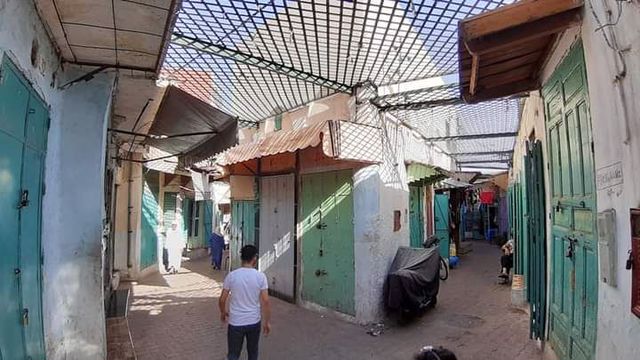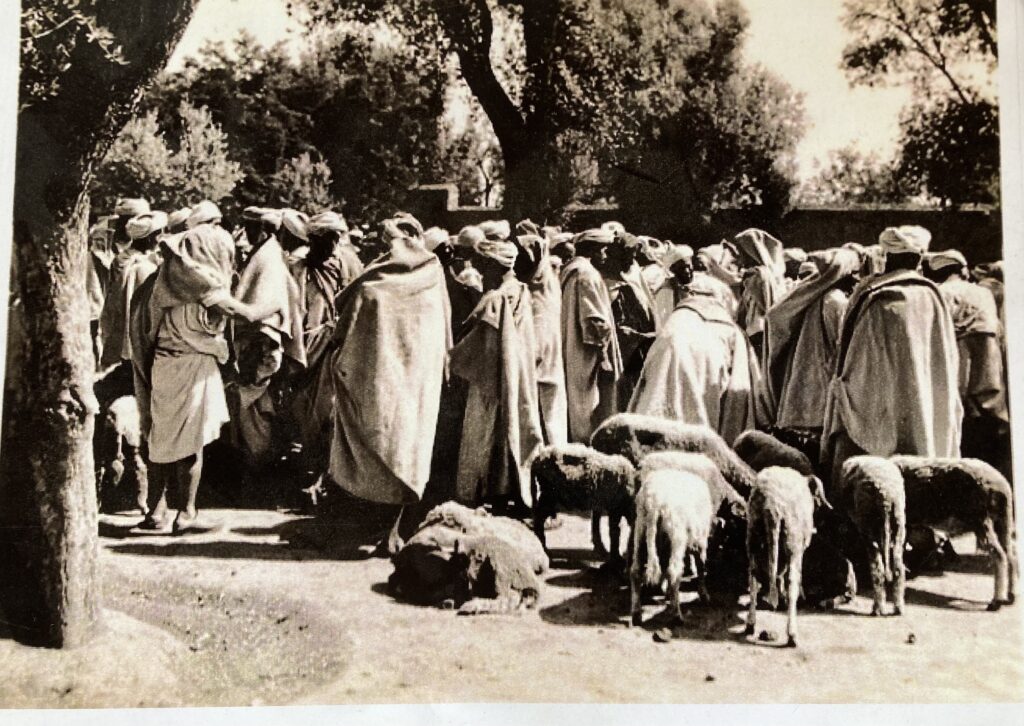
Zettata and Nisba: the Makings of Multiculturalism
The zettata
In the narrow sense, a zettata (from the Berber tazettat, “a small piece of cloth”) is a passage toll, a sum paid to a local power (Arabic: zettāt; Berber: azettat) for protection when crossing localities where he is such a power. In fact, it was more than a mere payment. It was part of a whole complex of moral rituals, customs with the force of law and the weight of sanctity – centering around guest-host, client-patron, petitioner-petitioned, exile-protector, suppliant-divinity relations – all of which are somehow of a package in rural Morocco. Entering the tribal world physically, the out-reaching trader had also to enter it culturally.
Protection in the Amazigh societies of the High and Middle Atlas is personal, unqualified, explicit, and conceived of as the dressing of one man in the reputation of another. The reputation may be political, moral, spiritual, or even idiosyncratic, or, often enough, all four at once. Benediction (the famous baraka), hospitality, sanctuary, and safe passage are alike in this: they rest on the notion that though personal identity is radically individual in both its roots and its expressions, it is not incapable of being stamped onto the self of someone else.
The zettata proper involved the establishment by the caravan sheikh of such a protective covering of borrowed personality at point after point along his route. The sheikh on the one side and the zettat on the other solemnly exchanged turbans, cloaks, saddle covers, or sections of tent material – ‘the little piece of cloth’ – to create a symbolic fusion of their public selves. This ritual usually took place in the local market with every man of local standing in attendance. Each time the sheikh came through thereafter, his zettat provided him with a small band of men, again more as a symbolic indication of the fact of protection than as a literal guard. Meeting his caravan at one limit of the zettat’s influence, this band conducted it, via a grand meal in the zettat’s camp at which the toll (paid in currency and adjusted to the size and value of the caravan) was negotiated, to the other limit, where the next escort of the next protector waited to begin the process anew. From the Tafilalt to Fez there were long chains of such relationships, enclosing the caravan sheikh in a series of local identities – Moha’s or Rahu’s or Lahcen’s – as he led his train through the turbulent countryside.
When, after around 1890, the Sefrou economy became a region-focusing bazaar rather than an emporium-linking caravan stop, the zettata type of protection pattern provided the mechanism by which the connection was made. The first connection was made by the Jews, who for months at a time, located themselves in the villages, camps, and markets of the countryside under the protection of one or another tribal strong man. Here, the protection pact was signalized by a sheep sacrifice – again public, with all the local men assembled for a meal in the protector’s tent – rather than a turban exchange. It was called a mezrāg.

A mezrāg was as solemn an undertaking, and based on the same complex of ideas about hospitality, personal reputation, the bindingness of oral contract, and divine human retribution, as the zettata relation between two Amazigh people, and it was at least as resolutely observed. It was essentially the same contract, but cross-ethnic and cross-religious.
The mezrag made, the protector (mūl l-mezrāg) would send a small group of his men down to Sefrou town to pick up the Jew and escort him and his goods to their locality. There, usually by the side of a small market or set off a few hundred metres outside a settlement, the Jew would trade for several months and, his stock exhausted, be escorted back home with his wool, hides, grain, or whatever. By the early 1900s, the countryside behind Sefrou was laced with Jewish-Amazigh mezrag relations of this sort. There was hardly a tribesman who, through the courtesy of his local strong man, did not have a riding Jewish trader reasonably nearby, and hardly a sitting Sefroui Jew, whose agents these riding Jews were, who did not have extensive mezrag-based interests in the countryside.
By the onset of the Protectorate, the penetration of Sefroui Jews into the surrounding countryside, the linking, through them, of isolated Amazigh markets to the town and to each other in an organized pattern, and the transformation of the town’s Muslims from a population overwhelmingly agricultural to one overwhelmingly commercial had wrought an economic revolution that the French establishment of security and improvement of transport merely consolidated.
Nisba : trade and cultural identity
Within the bazaar economy, the interrelations among the various kinds of people within it – sitting Jews, riding Jews, Amazigh chiefs, Arab notables, Saharan mule skinners, and a number of other types not yet mentioned – were intricate, crosscutting, and anything but distant. The bazaar economy was multicoloured from the start: different varieties of people entered it in differing degrees, in different ways, and with not altogether complimentary views of one another.

This promiscuous tumbling in the public realm of varieties of men kept carefully partitioned in the private one, cosmopolitanism in the streets and communalism in the home, is, of course, a general feature of Middle Eastern civilization. This is often called a mosaic pattern of social organisation – differently shaped and coloured chips are jammed in irregularly together to generate an overall design within which their distinctiveness remains intact. This mosaic pattern is made possible by a number of characteristic ideas: that religious truth is so little subject to argument and so little responsive to temporal concerns that it ought not to hinder practical activities; that non-Muslim groups are not outside Muslim society but have a scripturally allocated place within it; that law is personal and determined by who one is, not territorial and determined by where one is; and that, though usually cruel and always capricious, the state is a machine less for the governing of men, who are anyway more or less ungovernable, than for the amassment and consumption of the material rewards of power. Nothing if not diverse, Middle Eastern society, and Moroccan society as a frontier variant of Middle Eastern society, does not cope with diversity by sealing it into castes, isolating it into tribes, or covering it over with some common denominator concept of nationality. It copes with diversity by distinguishing with elaborate precision the contexts (marriage, diet, worship, education) within which men are separated by their dissimilitudes and those (work, friendship, politics, trade) where men are connected by their differences.

In mid-twentieth century Sefrou, the contrast between Jew and Muslim was perhaps the most vivid and obvious example of the way this concern for fitting differences together operates within the bazaar economy; it is hardly the only such contrast of importance. Ascriptive distinctions – generated out of language, religion, residence, race, kinship, birthplace, ancestry – run through the whole of the bazaar, partitioning the Muslim community into literally dozens of categories. In 1968-9, there were 1013 shops and ateliers in Sefrou’s permanent bazaar; among the ‘owners’ of these establishments there were represented no less than sixty-six different locally recognized “ethnic-like” categories. A similar analysis of the periodic bazaar would no doubt see these categories double.
The mosaic of Moroccan society is made up of trades and nisba types. The collective habit of classifying man into a large number of essentialist categories – categories resting on the general premise that a person’s provenance pervades his identity – is practically effected by the extensive use of a morphological process of the Arabic language known as nisba. Deriving from the root (n-s-b) for ‘ascription’, ‘attribution’, ‘imputation’, ‘relationship’, ‘affinity’, ‘correlation’, ‘connection’, ‘kinship’, nisba as a linguistic device consists of changing a noun into what we would call a relative adjective, by adding ī (fem. īya). Examples are: Sefrū/Sefrou – Sefrūwī/native son of Sefrou; or, Beni Yazga/a tribal group near Sefrou – Yazgī/a member of that group.
In Geertz’s 1960 bazaar survey, there was practically no single case where an individual’s nisba type was not generally known. People were far more likely to be ignorant of what a man does, how long he has been around, what his personal character is, or where exactly he lives than they are of where he fits – Sussi or Sefroui, Buhadiwi or Alawi, Yazghi or Yahudi – in the mosaic.
One important way in which the Sefrou bazaar is ordered, then, is by collectively naming men by their backgrounds. The Sefrou bazaar is a great heterogeneous collection of individuals sorted out partly by trade and partly by what one can only call, invoking again a grammatical term, attributive identity. Alawis are people descended from the Prophet; Adlunis are members of a particular patrilineage; Yahudis are adherents of a religious faith; Bhalulis are people from a large village (Bhalil) a few kilometres from Sefrou; Qlawis are inhabitants of a quarter of Sefrou; Yazghis are members of a particular tribe. And so on. Occupations themselves can form the basis of a nisba, as can allegiance to a religious brotherhood, a political commitment, or even individual circumstances. What is regular here is the attributive principle, the adjectival ascription to individuals of some dimension of their social setting and the use of such ascriptions as a framework, at once conceptual and institutional, of bazaar activity.
Original source: Clifford Geertz Meaning and Order in Moroccan Society
